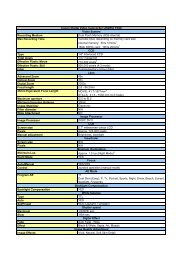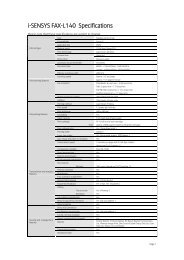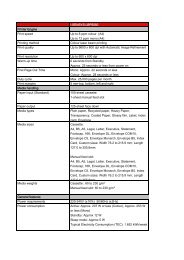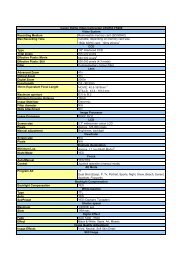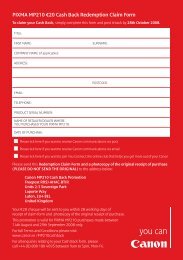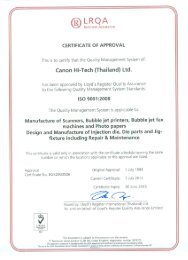Download a Work Method Statement document.
Download a Work Method Statement document.
Download a Work Method Statement document.
You also want an ePaper? Increase the reach of your titles
YUMPU automatically turns print PDFs into web optimized ePapers that Google loves.
Canon<br />
FIELD SERVICE TECHNICIAN<br />
WORK METHOD STATEMENT (MODEL)<br />
Attending a customers premises<br />
Onsite work requirements<br />
Installation of equipment<br />
Maintenance / repair of equipment & waste handling<br />
Substances used<br />
Technology Training & Support<br />
Canon Business Solutions<br />
Created December 1998<br />
Revised 23 rd April 2007 Rev 4.00
ARRIVAL ON CUSTOMERS PREMISES<br />
Upon arrival at your premises, whether this visit is solicited, scheduled or otherwise,<br />
our technical representatives will seek permission for entrance. Prior to access being<br />
granted they will be prepared to observe all stated or demonstrated Health & Safety<br />
requirements, along with any specific risks identified by you as inherent to your<br />
business.<br />
Our staff will adhere to any site rules and regulations for your work environment,<br />
which may be laid down as risk control measures. We would expect this to include<br />
suitable arrangements for security and the safe evacuation of our staff in an imminent<br />
danger or emergency situation.<br />
References<br />
- The Health & Safety at <strong>Work</strong> Act 1974<br />
- The Provision & Use of <strong>Work</strong> Equipment Regulations 1998<br />
- The Management of Health & Safety at <strong>Work</strong> Regulations 1999<br />
- The <strong>Work</strong>place (Health, Safety and Welfare) Regulations 1992<br />
- The Fire Precautions Act 1971 & ‘Reform’ requirements<br />
- The Electricity at <strong>Work</strong> Regulations 1989<br />
ONSITE WORK REQUIREMENTS<br />
In order for our service representatives to effectively undertake a safe working practice<br />
(safe for both our staff and your employees), your site would conform to the basic<br />
requirements of the following Health & Safety regulations:-<br />
1. Electricity at <strong>Work</strong> Regulations 1989<br />
‣ In particular ‘The Provision of Adequate <strong>Work</strong>space, Access and Lighting’<br />
for technicians working on electrically energised equipment.<br />
2. The <strong>Work</strong>place Health, Safety and Welfare Regulations 1992<br />
‣ Unless exempt by virtue of nature of business, premises or undertaking,<br />
i.e. home forces or construction sites.<br />
Page 1 of 6
INSTALLATION OF EQUIPMENT<br />
Preparation<br />
Equipment will be unpacked from cardboard boxes and other wrappers using, where<br />
necessary, basic cutting tools, i.e. Stanley knife or safety blades. Any resultant waste<br />
will be confined as practicable to areas designated by customer’s staff in order to keep<br />
to a minimum any hazards which may result, such as ‘trip’, ‘combustion’ or ‘impeding<br />
of gangways’.<br />
Checks<br />
A secure and stable position for the equipment will be agreed with the customer in<br />
accordance with future service requirements and giving due regard to the approved<br />
codes of practice for the ‘Provision and use of <strong>Work</strong> Equipment Regulations 1998’.<br />
Pre-installation checks of the electrical supply will be carried out by our service<br />
technician. A specific integrity test will be conducted using a positive indication test<br />
tool which will be plugged into the mains outlet (assuming a conventional 3 pin outlet<br />
has been provided). Any apparent negative results would be raised with the customer<br />
for discussion / verification and correction, before proceeding with use of the mains<br />
supply.<br />
All electrical suitability checks conducted will be done in the best interest of customer<br />
and technician safety with due regard for the ‘Electricity at <strong>Work</strong> Regulations 1989’.<br />
The integrity of our product, both electrical and mechanical, will be confirmed during<br />
the set up commissioning and in all subsequent service visits.<br />
References<br />
‣ The Provision and Use of <strong>Work</strong> Equipment Regulations 1998<br />
‣ The Electricity at <strong>Work</strong> Regulations 1989<br />
Page 2 of 6
SET UP COMMISSIONING<br />
Our service technician will display a notice at all times during the service work,<br />
informing customer personnel of the main hazards to which they may be exposed. It<br />
is expected that any passers by will take, in the spirit intended any guidance provided,<br />
whether it be directly or in notice form, entirely in the interest of everyone’s Health,<br />
Safety and Welfare.<br />
Tasks<br />
• Disassembly<br />
The product will usually require partial disassembly for set up work and<br />
inspection purposes. This involves using a range of standard hand tools to<br />
remove product outer covers and sub assemblies. All such disassembly will be<br />
conducted in an orderly and tidy fashion with the expectation that adequate<br />
space will be made available to accommodate this work, thereby minimising<br />
the risks associated with this type of activity.<br />
• Loading Consumables<br />
Consumables such as toner powder, developer mixture, silicon oil and paper<br />
will be loaded as applicable by the service technician. This activity is carried out<br />
using a careful and controlled work method; most chemical compounds employ<br />
a specially designed dispenser which makes spillage or accidental release<br />
unlikely to occur. Any risks associated with this activity are therefore strictly<br />
controlled.<br />
N.B. All Canon consumables are non-toxic, non-carcinogenic and low hazard in<br />
normal use or exposure. Material safety data sheets are available on request<br />
from your local service provider.<br />
• Integrity Testing<br />
Whilst the product complies with all applicable national and EC safety<br />
standards, electrical and mechanical integrity checks are performed as a part of<br />
the installer and maintainers responsibility. This means visual inspections and<br />
the use of electrical test equipment (basic test meter) by the technician. This<br />
will include the kind of activity which re-affirms product stability, e.g. continuity<br />
of earth wiring, an insulation resistance test and the security of cable clamping.<br />
Powered or ‘live’ checks will not be performed at this stage; therefore any risks<br />
associated with the electrical hazard are very low.<br />
• Re-assembly of Sub Assemblies and Running Tests / Adjustments<br />
A range of standard hand tools will again be used to re-fit sub-assemblies, the<br />
product will then be commissioned and powered, often with outer covers or<br />
doors open / removed for running tests and adjustments. All such tests will be<br />
closely monitored and guarded by the service technician to protect other<br />
persons from exposure to any physical, mechanical and electrical hazards which<br />
will be posed due to guards being removed.<br />
Running tests / adjustments may require technician use of standard test meter<br />
type equipment, however, this is unlikely to involve hazardous voltages unless<br />
malfunctions have occurred (in which case see ‘Maintenance and Repair of<br />
Equipment’ for further details).<br />
Page 3 of 6
MAINTENANCE & REPAIR OF EQUIPMENT<br />
Maintenance and repair activities naturally include some aspects of the work discussed<br />
in ‘Installation of Equipment’, these include:-<br />
1. Supply Integrity Checks -<br />
The continued suitability is checked using the same method and with the<br />
same possible outcomes.<br />
2. Product Integrity Testing -<br />
The continued stability of the product is confirmed using the same<br />
techniques and equipment. Once again in the context of ‘maintenance’,<br />
powered or live checks will not be routinely performed at this stage but<br />
rather as and when any fault situation justifies.<br />
3. Disassembly and Re-assembly -<br />
For maintenance disassembly this is likely to be more extensive than<br />
required during installation, whilst for repair the degree of work will be<br />
determined by the nature of the product malfunction. In each case a range<br />
of standard hand tools will be used.<br />
All disassembly and re-assembly will be conducted in an orderly and tidy<br />
fashion, with the expectation that adequate space will be made available for<br />
our technician’s use as an aid to risk control during this activity.<br />
4. Running Tests / Adjustments -<br />
For fault diagnosis and repair it may be necessary to perform running tests<br />
to unguarded machinery, this will only occur after it has been confirmed safe<br />
to do so. Additionally, this may include ‘live’ electrical tests to hazardous<br />
voltages using electrical test equipment – This is one of the many reasons<br />
for our technician giving clear notification to ‘keep clear of maintenance<br />
work’. In this way, risks from electricity are under the control of our<br />
technician and risks should not extend to third parties.<br />
5. Cleaning / Use of Substances and Waste Handling -<br />
In the course of routine maintenance and repair work, cleaning of machine<br />
parts is carried out. This activity can be broken down into four categories, as<br />
follows:-<br />
• Removing Loose Toner Particles and Dust.<br />
Damp wiping or vacuuming is our recognised best practice, using<br />
disposable wipes and cloths to lift toner and dust deposits or a propriety<br />
vacuum cleaner to remove larger volumes. With the former method,<br />
lifted dust is discarded as normal refuse and in the later case dust is fully<br />
contained within the vacuum cleaner, only where this becomes full<br />
during use, will disposal be arranged with our customer.<br />
Full risk assessments have been conducted and used to develop the<br />
technicians work method. For safe handling of dust in the workplace<br />
further information is available from your local service provider.<br />
Page 4 of 6
• Removal of Spent or Contaminated Consumables -<br />
Small components, which have achieved the end of their service life and<br />
contaminated process consumable substances (such as toner, starter<br />
and silicon oil), will be manually removed from the product using a safe<br />
system of work, which reduces the risk of spillage; then sealed into scrap<br />
bags for disposal by agreement on the customer’s premises.<br />
Repairable / refurbish able components will be taken away by our<br />
technician, alternatively separate arrangements will be made.<br />
• Degreasing of Mechanical / Optical Parts -<br />
Using cleaning agents and disposable cloths / wipes, both mechanical<br />
and optical components may be cleaned. Wipes and cloths moistened in<br />
cleaning fluids will be disposed of in a manner agreeable to the<br />
customer.<br />
• Removing Stains -<br />
Using cleaning agents and disposable cloths / wipes, various areas of<br />
the product will require stain removal. The types of stains include<br />
oxidisation, hardened toner or dried ink deposits and effects from the<br />
environment or discoloration.<br />
Cleaning agents are supplied to our technicians in spill proof containers<br />
(spray) and are used in restricted amounts dispensed into an absorbent<br />
material. This method effectively delivers the cleaning agent to the stain<br />
whilst minimising technician or third party exposure.<br />
Page 5 of 6
SUBSTANCES USED<br />
Installation, maintenance and repair of our products require the use of some cleaning<br />
substances, which are commonly used in this industry. Three basic types are in<br />
general use and whilst full material safety data sheets are available from your local<br />
service provider. A general outline of these products follows:-<br />
• Foam Cleaner<br />
A general purpose-cleaning agent which is spray delivered to the spot<br />
requiring cleaning or onto a cloth for work on large areas.<br />
This product delivers a heavy spray which foams on contact with surfaces; it<br />
is a mild solvent detergent formulation with a not unpleasant odour. Whilst<br />
it does contain flammable solvents, it is not particularly volatile which<br />
means there is little risk of ignition during normal use.<br />
• Cleaning Solvent<br />
Used in specific de-greasing applications this agent is spray delivered (to<br />
eliminate the risk of leakage) directly onto an absorbent cloth for use in<br />
small quantities on small areas. This product is classified as extremely<br />
flammable, hence our restriction of its use. It should be used in a wellventilated<br />
area and in isolation from any source of ignition.<br />
Vapour has a distinctive odour and one should avoid inhalation, although<br />
its restricted use should present little risk in this area.<br />
• Glass Cleaner<br />
A propriety solution is used for cleaning glass optical assemblies; it consists<br />
of a water / detergent mix with a very low odour. This product is low hazard<br />
in recommended use and presents little risk to health. It is dispensed by<br />
pump action spray but can be poured after removing the screw top, since<br />
spillage would not present any exposure problems.<br />
All substances used by our technicians in their field service work are carefully<br />
selected and assessed under the requirements of the Control of Substances<br />
Hazardous to Health Regulations 2002; thereby reducing the risks from<br />
exposure or use, whilst providing effective performance in their application.<br />
Full material safety data is available from our ‘Information Management’<br />
department at address below, or under ‘product’ on the following Internet<br />
address – www.canon.co.uk/health_safety/<br />
Canon (UK) Ltd<br />
Woodhatch,<br />
Cockshot Hill,<br />
Reigate,<br />
Surrey.<br />
RH2 8BF<br />
TEL: 01737 220 000<br />
Page 6 of 6





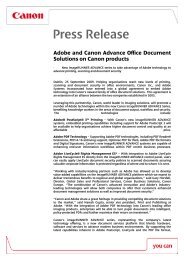
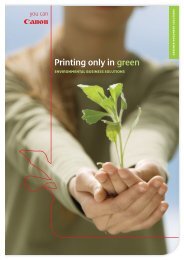
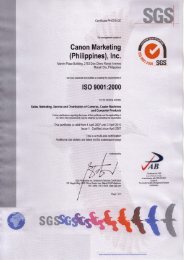

![Consultancy Brochure [PDF, 254 KB] - Canon Ireland](https://img.yumpu.com/36277858/1/189x260/consultancy-brochure-pdf-254-kb-canon-ireland.jpg?quality=85)
